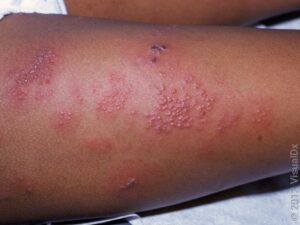What Is a Shingles Rash?
Shingles (medical name: Herpes Zoster) is a painful skin rash caused by the varicella-zoster virus—the same virus that causes chickenpox. After you’ve had chickenpox, the virus stays dormant in your nerve cells and can reactivate years later as shingles.

Symptoms of a Shingles Rash
- Early Signs (1–3 days before rash):
- Burning, tingling, or stabbing pain on one side of the body or face
- Itching or sensitivity in a specific area
- Fever, chills, or headache (less common)
- Rash Appearance:
- Red patches that develop into fluid-filled blisters
- Usually appears on one side of the torso, face, or neck
- Blisters crust over within 7–10 days
- Rash usually clears in 2–4 weeks
- Pain:
- Can be intense and persistent
- May continue after the rash heals (called postherpetic neuralgia)
📍 Where It Typically Appears
- One side of the torso, face, neck, or eye area
- Follows a nerve line (called a dermatome)
🚨 When to See a Doctor
- Rash near the eyes (can lead to vision loss)
- If you’re over 50 or have a weakened immune system
- If the pain is severe or spreading
- If the blisters continue to appear after 7 days
💊 Treatment
- Antiviral medications (like Acyclovir, Valacyclovir) – best within 72 hours of rash onset
- Pain relief: over-the-counter painkillers, cool compresses, calamine lotion
- Nerve pain meds: sometimes prescribed for long-term discomfort
✅ Prevention
- Shingles vaccine (Shingrix) is recommended for adults 50+
- Helps reduce risk of shingles and postherpetic neuralgia
🛑 Important Notes
- Not contagious as shingles—but can spread chickenpox to someone who hasn’t had it (through direct contact with the rash)
- Keep rash covered and avoid touching it
